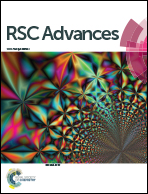Insight on the effect of Ni and Ni–N co-doping on SnO2 anode materials for lithium-ion batteries
Abstract
With the increased demand for high-rate performance Li-ion batteries, it is necessary to find available methods to improve the rate properties of SnO2 electrodes. It is noteworthy that doping was considered to be a feasible means. The electronic structures and diffusion energy barriers of Ni-doped and Ni–N co-doped SnO2 were calculated based on density functional theory. The results estimated that the energy gaps of Ni-doped and Ni–N co-doped SnO2 are 1.07 eV and 0.94 eV, which both are smaller than the value of 2.08 eV of SnO2. These exhibit that the conduction properties of SnO2 can be enhanced by doping with the Ni or Ni–N atoms. Moreover, the diffusion properties of Li can also be improved by doping with Ni–N atoms due to the diffusion energy barrier of Li from the B to C point for Ni–N co-doped SnO2 being 0.12 eV smaller than the value of 0.24 eV for the pristine SnO2. Meanwhile, the diffusion energy barriers of Li along other pathways for Ni–N co-doped SnO2 are almost the same as 0.24 eV for SnO2. These results show that both the electronic and ionic conductivity of SnO2 can be enhanced by Ni–N co-doping, which provides a theoretical explanation to promote the rate properties of SnO2 by Ni–N co-doping as anode materials for Li-ion batteries.



 Please wait while we load your content...
Please wait while we load your content...